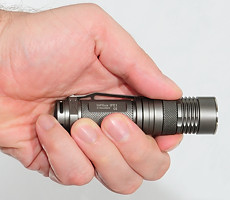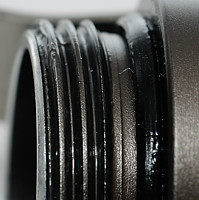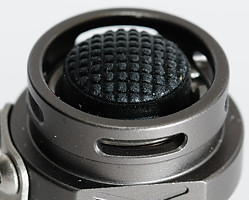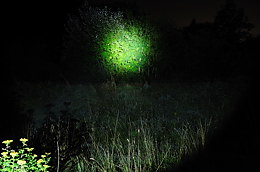NiteCore Infilux IFE1



NiteCore has made many different lights, including light with stepless brightness selection and with a ring for brightness selection, but this is the first time they combines these two abilities to a light with a stepless ring to select brightness. This light is supposed to be the start of a series, the supplied manual covers both IFE1 and IFD2 (2xAA). The light is made of aluminum with hard-anodized (Type 3) finish.


The light is supplied in a plastic case, I believe that this is a rather elaborate box to supply the light in. The markings on the case are easy to remove, making it possible to use the box for other stuff.

Here is the contents of the case, the light a lanyard, extra boot for the tail switch, spare o-ring, a manual and a warranty card.


From the front the bezel ring in titanium can be seen protecting the smooth reflector with a XP-G led in the bottom. The smooth reflector gives a few rings in the beam, but does not succeed in making the light a thrower.


At the back of the head is the magnetic control ring. This ring has one stop, where the light is in standby (light off, but uses power). Turn one way and strobe is activated, turn the other way and the light start at low brightness and about 270 degrees later is maximum brightness. There are a few problems with this implementation, it is not possible to select the lowest brightness light level, because the ring will snap back to the stop. The regulation is linear, this is not very smart because most of the 270 degree rotation only changes the brightness a little bit, all the brightness change is in the small part just before the stop. 270 degree rotation to change brightness is also a lot of rotation, 120 degree would probably have been enough.
The sos function is hidden, to trigger it the brightness must be turned high/low 3 times fast, then it is possible to adjust the brightness of the sos. To leave sos, adjust the ring to very low brightness or turn the light off.

To illustrate the log/lin issue I have made a curve with a logarithmic scale (This curve is a calculated curve and not measured on the light). The blue line illustrates how the ring feels, where most of the regulation is just before the stop. If the ring had used a logarithmic scale the perceived brightness would have followed the red curve.

Triangular threads with a smooth feel, there is a o-ring at the end of the threads. It is possible to lock out the led by losing the head, but this will also break the o-ring seal.

The head has a nicely done finish on the battery side, no circuit board is visible and with mechanical polarity protection (The plastic ring around the center).

Looking into the body there is a spring.

The knurling has some bite to it, especially on the ring.

The light has a titanium clip that is screwed on.

The switch is a forward switch, the guard around the switch is not high enough to allow tail standing. The lanyard can be mounted in holes in the guard.

I could dismantle the light into these parts without tools, but on some of the lights the head is glued on.
The light looks very nice and is designed and manufactured very good for the mechanical part of it. The stepless ring is also a very innovative feature. I do not like the linear brightness control with problems selected low levels and the driver has some strange behavior (See my curves of pwm). An improved driver and logarithmic brightness control, where it is possible to select all brightness steps and this light will be a very good light.
Technical specification and measurements

The light can run on either a CR123 or a 16340 LiIon battery.
Measured size and weight:
Length: 102.2 mm
Diameter: 21.1 to 25.2 mm
Weight: 81.1 gram with CR123, 83.5 gram with 16340 LiIon battery
The light uses a Cree XP-G R5 led.

In the above table I have used 1400mAh CR123 batteries for estimating the runtime. Note that the standby function does use a lot of power, it will drain a CR123 battery in less than 4 days! The estimated lumes are based on the specified 260 lumen.

The voltage scan shows that the light has a good regulation down to about 1.5 volt, but a LiIon will increase the output. On the case it says that the light has a buck/boost regulator, but this curve do not confirm that. It can also be seen that the light has a very high current draw, it goes above 3.5 A when the battery is nearly drained. It might have been a good idea to fall out of regulation at a higher voltage to keep the current draw more reasonable.

I used two different LiIon batteries to measure the runtime (They was tested at 531mAh and 575mAh with 0.5 A current draw). With CR123 the light drops out of stabilization rather fast, I believe that this is due to the high current draw (that is the price for the high brightness). The irregularities when out of stabilization if probably due to flicker (see below).

The light uses pwm to control brightness, here I have capture it when highest brightness is selected. The light only turns the led on for 62% of the time, usual this would be 99% to 100%. This means that the driver handles extra high current because it must deliver all the power in only 62% of the time, this increases the losses in the driver and the led, i.e. the light has lower efficiency than possible.

This is one of the lowest settings that I could select with about 2.5% pwm.

Usual the first two pwm curves would be all that was necessary to show of the pwm, but in this case I have to throw in a few extra curves. The curve above shows that the frequency is not stable, the driver changes between two different frequencies (23kHz and 12kHz), both high enough to be invisible.

The same here, but with higher brightness setting. The output brightness is higher with the lower pwm frequency.

While testing the light, the output got unstable (Looks like flicker). I captures the brightness and it looks very strange with the output switching on/off (This is neither sos or strobe). I cannot guess what is going on here!

The strobe is a fast strobe at 12.3 Hz with 60% duty cycle.

Turning the brightness up/down 3 times fast will change to SOS mode. The dot is 0.33 second and the total sos is transmitted in 8.5 second, then a 1.3 second pause before the next.
Comparison to other Flashlights
NiteCore Infilux IFE1 CR123, NiteCore Infilux IFE1 LiIon, JetBeam RRT-0 CR123



JetBeam RRT-0 LiIon, 4Sevens Quark 123 R2 CR123, 4Sevens Quark 123 R2 LiIon



For the full comparison to other lights with graphs and beamshots see here.


































